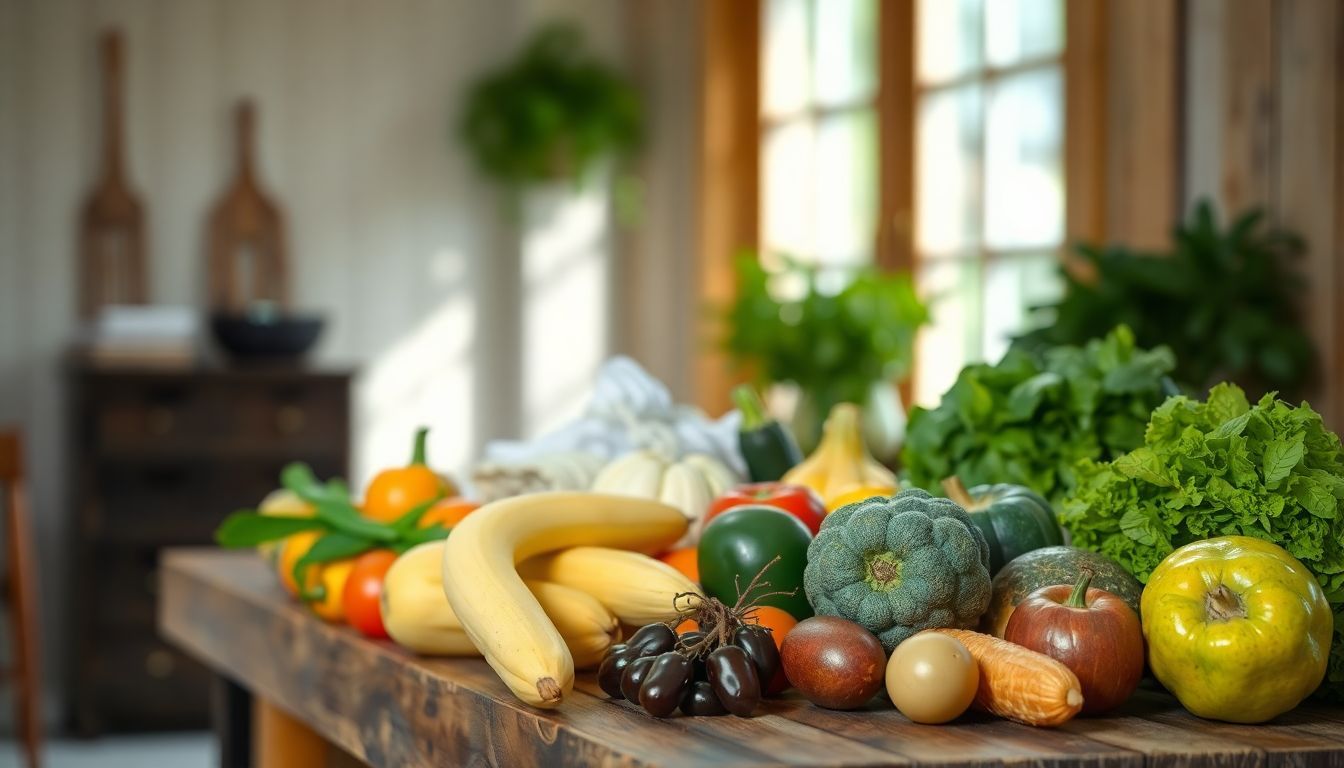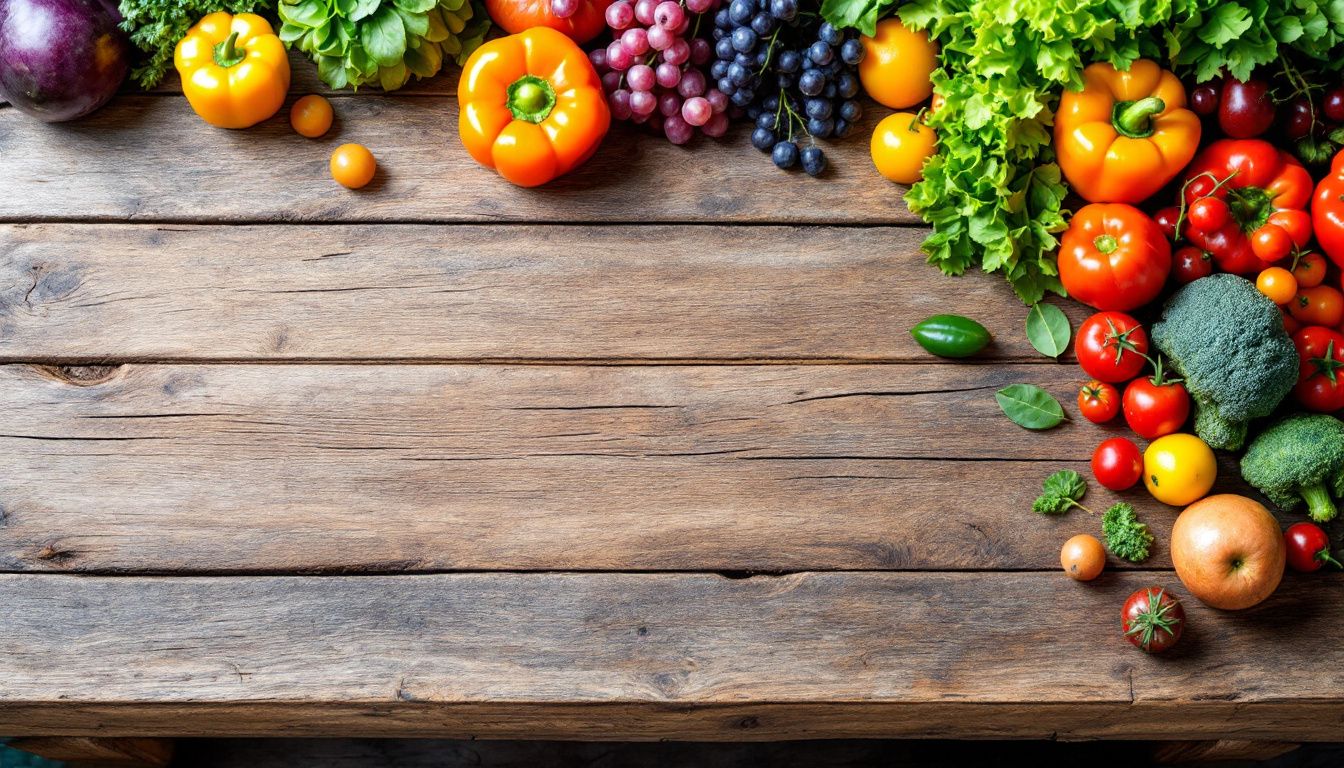Switching to healthier eating can feel overwhelming at first. A plant-based diet is linked to better health, weight management, and lower risks of heart disease and type 2 diabetes.
Thank you for reading this post, don't forget to subscribe!This guide will show you easy steps to make the change without stress. Ready to feel your best?
Key Takeaways
- A plant-based diet lowers the risk of heart disease, type 2 diabetes, and some cancers. It also supports weight loss and brain health. Foods like lentils, nuts, and whole grains are key.
- Eating more plants helps the environment by reducing greenhouse gas emissions by up to 52% and cutting water use by up to 27%. Switching from meat to options like oat milk or bean-based dishes makes a difference.
- Start small with one plant-based meal daily. Replace animal products gradually with alternatives such as tofu or almond milk. Focus on whole foods like fresh vegetables and legumes for better nutrition.
- Meal prep boosts success—batch cook items like quinoa or beans ahead of time. Try recipes using swaps like nutritional yeast for cheese flavor or silken tofu for protein in meals.
- Address nutrients by eating fortified foods (e.g., soy milk with calcium) and pair iron-rich legumes with vitamin C sources (like oranges). Apps can help find plant-friendly restaurants while traveling!
Why Transition to a Plant-Based Diet?
A plant-based diet can improve your health and protect the planet. It offers a simple way to make better choices for yourself and the environment.
Health benefits
Plant-based diets can lower the risk of many major diseases. Studies show eating more plant-based foods helps prevent Type 2 diabetes, heart disease, and some cancers. Diets rich in fruits, vegetables, whole grains, and healthy fats also fight obesity and high blood pressure.
They reduce bad cholesterol levels and improve insulin resistance. Research even links these diets to a longer life.
Plant-based nutrition supports brain health too. It may help protect against Alzheimer’s disease and depression over time. People switching to whole foods like legumes, nuts, seeds, and brown rice often lose weight naturally because these foods are lower in saturated fat but full of fiber.
“Eating plants isn’t just good for your body—it’s great for your mind.
Environmental impact
Eating more plant-based foods helps the planet. Cutting animal products can lower greenhouse gas emissions by 30-52%. It also uses less land, reducing land use by 20-45%. Growing plants for food needs fewer resources compared to raising animals.
For instance, freshwater use drops by 14-27% when people shift toward plant-based diets.
Between 2018 and 2020, the European Union saw a huge jump in demand for plant-based alternatives—a rise of 49%. This shows how many people are choosing sustainable options. Eating meals like black bean burgers or using oat milk instead of dairy can make a big difference.
Every small step adds up to protect our planet from climate change and overuse of natural resources.
Power Up Your Diet: Health Benefits and Tips for Plant-Based Meals
A plant-based diet can lower the risk of heart disease, type 2 diabetes, and certain cancers. Foods like beans, lentils, nuts, and tofu are high in plant-based protein. Eating whole foods is also key.
Whole grains such as brown rice and oats provide fiber to keep your digestion healthy. Healthy fats from olive oil or avocado help with brain function and reduce cholesterol levels.
Start small—try meat substitutes or add more vegetables to meals like stir-fry or pasta. Replace regular milk with almond milk or soy products for breakfast cereals. Plan ahead by creating a vegan meal plan using minimally processed foods that include legumes, whole-grain breads, and lots of leafy greens.
Batch cooking makes sticking to these choices easier during busy weeks!

Steps to Transition to Plant-Based Eating
Switching to plant-based eating can feel overwhelming, but small steps make it easier. Focus on simple changes and enjoy the process of trying new foods.
Start with one plant-based meal per day
Try eating one plant-based meal each day. This simple step can make a big difference in cutting back on animal products. Start with easy options like oatmeal topped with fruits and nuts for breakfast.
You could also try a lunch of black beans, brown rice, and avocado or enjoy a hearty lentil soup at dinner.
The Meatless Monday campaign supports this idea by suggesting meat-free meals at least once a week. Over time, these small changes help you explore new foods while boosting your health and the planet’s well-being.
Next comes learning how to replace more animal products with tasty plant-based alternatives….
Gradually replace animal products with plant-based alternatives
Start by removing two animal-based foods from your diet. Replace them with plant-based options like tofu, lentils, or chickpeas. Swap cow’s milk for plant milks such as almond milk, oat milk, or soy milk.
Use flaxseed eggs in baking instead of regular eggs.
Replace meat one meal at a time. Try faux meats for familiar flavors or lean on hearty vegetables like mushrooms and eggplant. Gradually cut back on dairy products after replacing meat—use nutritional yeast for a cheesy taste without the dairy.
Explore weekly new fruits and vegetables to keep meals exciting.
Next step: Focus on whole, minimally processed foods…
Focus on whole, minimally processed foods
Switching to whole, minimally processed foods keeps meals healthy and simple. These include fresh fruits, vegetables, legumes, nuts, seeds, whole grains like brown rice or whole wheat bread—packed with fiber and nutrients your body needs.
Avoid fast food or ultra-processed items high in added sugars or artificial sweeteners.
Skip refined grains like white bread and focus on healthier options such as quinoa or oats. Choose plant-based protein sources like lentils over processed vegan meats. Whole-foods provide better energy while being low in saturated fat—and they help prevent heart disease and type 2 diabetes!
Essential Components of a Plant-Based Diet
A plant-based diet thrives on fresh produce, hearty grains, and protein-packed legumes—explore how these foods can transform your meals.
Fruits and vegetables
Fruits and vegetables pack a punch of fiber, vitamins, and minerals. Leafy greens like spinach provide iron, while oranges offer vitamin C. High-nutrient options such as sweet potatoes or yams are filling and support overall health.
Frozen fruit reduces waste and stays fresh longer—perfect for smoothies or snacks.
Stock up on colorful produce to diversify meals. Broccoli, carrots, and bell peppers add crunch to dishes while boosting nutrients. Focus on minimally processed choices to improve heart health and weight management.
Eating more fruits can also help reduce the risk of type 2 diabetes or chronic conditions like cardiovascular disease over time.
Legumes, beans, and lentils
Fruits and vegetables provide vitamins, but legumes, beans, and lentils bring protein power. These plant-based proteins also deliver fiber and minerals like iron and magnesium. Eating them regularly supports cardiovascular health.
They help manage type 2 diabetes by controlling blood sugar levels.
Legumes aren’t just healthy for people—they’re good for the Earth too. Their roots work with bacteria to fix nitrogen in soil, reducing the need for chemical fertilizers. Lentil soups or bean-based chili are easy vegan meal plan ideas that taste great while keeping meals sustainable.
Whole grains and nuts
Legumes and beans add protein, but whole grains and nuts bring fiber, vitamins, and healthy fats to a plant-based diet. Brown rice, quinoa, oats, or even yuca provide energy while helping manage weight.
These whole foods also support heart health and reduce plaque buildup in arteries.
Nuts like almonds or walnuts add crunch—and essential nutrients. They contain healthy fats that lower heart disease risks. A handful of nuts daily can improve cholesterol levels too.
Pair them with plant-based milk like oat or almond for a filling snack full of benefits!

Tips for Success
Planning ahead can make plant-based eating easier and fun. Experiment with new ingredients to keep meals exciting and flavorful.
Meal planning and preparation
Make a vegan meal plan twice a week to save time and stress. Cook grains like brown rice or quinoa, as they last for days. Batch cook beans, lentils, or silken tofu for quick protein options during the week.
Prepare sauces ahead of time—try a creamy vegan Caesar dressing or soy-based stir-fry sauce. Replace animal ingredients with plant-based alternatives like oat milk in recipes. Stock up on whole foods such as nuts, seeds, and legumes to keep meals nutritious yet simple.
Explore plant-based recipes
Cooking plant-based recipes can be fun and easy. Try meals like vegan black bean and corn salsa or vegetarian pesto-stuffed mushrooms with Parmesan. These dishes taste great and pack nutrients from whole foods like beans, vegetables, and herbs.
Using resources such as “The Mayo Clinic Diet” cookbook or MyPlate.gov helps you discover new ideas.
Experiment with swaps for animal products—use almond milk in smoothies or nutritional yeast on pasta for a cheesy flavor. Whole grains like brown rice add filling fiber to meals.
Start small by meal prepping one or two plant-forward options each week… ready-made when hunger strikes!
Next: Learn about building a support system for success in your diet transition!
Build a support system
Trying new plant-based recipes is fun, but sharing them makes it better. Involve your family in meal planning to make the switch smoother. Cook plant-based meals together or invite friends for a vegan dinner party.
Sharing food builds connection and encourages others to join your journey.
Explore plant-based restaurants with loved ones for variety and inspiration. Asian, Ethiopian, and Indian spots often have tasty options that fit into a vegan diet. If you’re working with a doctor or nutritionist, ask for ongoing support as you adjust to this lifestyle change.
Having encouragement from people around you keeps motivation high!
Common Challenges and How to Overcome Them
Switching to plant-based eating can feel tricky at first. Small steps and smart choices make it easier to stay on track.
Addressing nutritional concerns
Protein worries are common in plant-based eating, but they shouldn’t be. Adults need about 50 grams daily or 0.8 grams per kilogram of weight. Foods like lentils, beans, tofu, and nuts offer excellent plant-based protein options.
Adding whole grains like quinoa or brown rice boosts your intake too.
Vitamins and minerals like calcium, vitamin B12, iron, and zinc also need attention. Fortified plant-based milks such as soy milk or almond milk provide calcium and vitamin D. Nutritional yeast adds a good source of B12 to meals for vegans or those on vegetarian diets.
Iron from legumes is better absorbed when paired with foods rich in vitamin C—like oranges or tomatoes.
This focus builds confidence toward staying consistent while dining out…
Staying consistent while dining out or traveling
Look for plant-based meals on the menu. Many restaurants now offer vegan or Mediterranean diet options like brown rice bowls, salads, or oat milk lattes. Use apps to find spots offering whole foods or minimally processed dishes nearby.
Carry snacks like nuts and seeds while traveling. Frozen ready-to-eat plant-based foods can also be lifesavers during busy days. Stay hydrated with water or healthy drinks like soy milk to curb cravings and avoid bloating.
Focus next on overcoming common nutritional concerns in your diet transition.
Conclusion
Switching to a plant-based diet can transform your health and well-being. Small steps, like adding more veggies or trying new recipes, make the change easier. Over time, you’ll feel the benefits in your body and mood.
The planet wins too! Take it one meal at a time—it’s worth it.
